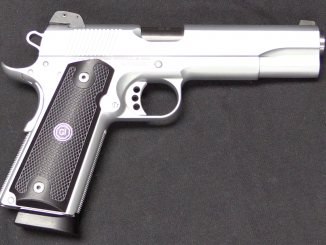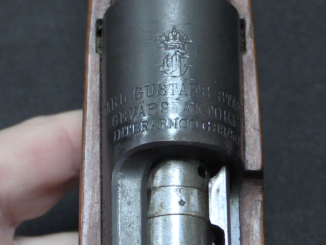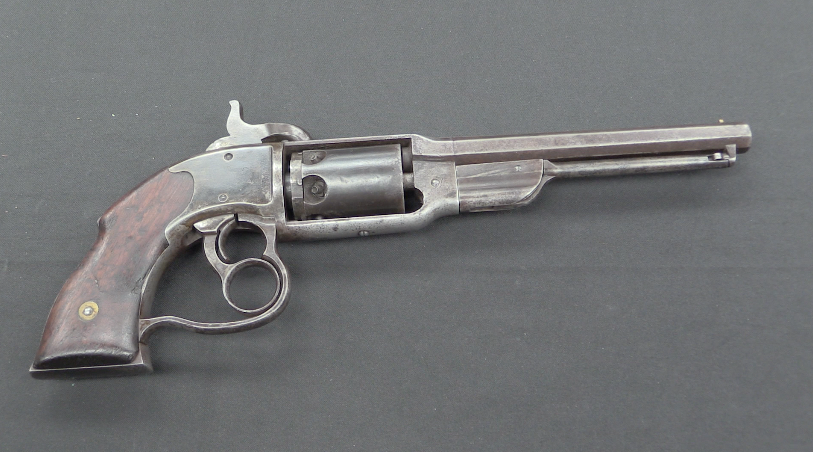Guns in this video:
Folding stock Model A
Folding stock Model B
Wood stock Model B
Although it was adopted by the Israeli military in the 1950s, the Uzi submachien gun did not generate much interest in the United States until the 1980s. The guns were used in limited numbers by the CIA covertly in Vietnam (and elsewhere), and also by various security elements of the US government – like the Secret Service. The events that would change this began in the 1970s when Uzi Gal left the Israeli military and moved to the United States, where he was hired by a company called Action Manufacturing.
The owner of the company, Harry Stern, got the idea to market a semiautomatic variant of the weapon, and Uzi himself designed the modifications to make it semiautomatic only. The resulting gun was then produced by IMI in Israel and imported by Action Arms, a new branch of Action Manufacturing. The gun was introduced at the 1980 SHOT Show, and proved to be very popular. By the time the 1989 import ban ended importation, Action Arms sold about 72,000 of the guns.
There were two main variations of the semauto Uzis made by IMI for Action Arms, the Model A and Model B (which replaced the A in 1983). The Model B added a firing pin safety that eliminated the possibility of the gun firing out of battery, which had been possible on the Model A. The B also incorporated some minor changes to the sights and sling swivels.
For more detailed history of the Uzi, both in military and civilian forms, I highly recommend David Gaboury’s new book “The Uzi SMG Examined“.




Jun Jesus is going to the holy land?! Oh yeah! So many memes awaits…
Uziel Gal left Israel shortly after his design for assault rifle, the Gal AR, failed at the IDF trials in the late 60’s to IMI other gun – the Galil AR. There were stories ever since about corruption and that the trials were rigged against Gal as IMI pressed hard for their favorite child the Galil.
I detect rabid moral guardians who can’t tell the difference between the items here and crappy copies of the Browning pocket guns. Most murders are never done by military grade guns anyway! But that aside I must say Israeli guns have come a long way from surplus German equipment (then again, lots of countries in that area used German surplus anyway!). When did the Arab nations start importing Russian stuff, anyhow?
“Israeli guns have come a long way from surplus German equipment”
Article about Arab-Israeli war in English wikipedia has nice table:
https://en.wikipedia.org/wiki/1948_Arab–Israeli_War#Weapons
so as you can see big variety of equipment and this apply to both side, BTW: 120 mm French mortars seems to be erroneously linked as it lead to weapon produced since 1960s.
BTW: If you wonder what Avia S-199s is doing here see:
https://en.wikipedia.org/wiki/Arms_shipments_from_Czechoslovakia_to_Israel_1947–49#Deliveries
“When did the Arab nations start importing Russian stuff”
At least since 1955, see: https://en.wikipedia.org/wiki/Egyptian–Czechoslovak_arms_deal
The Egypt and Syria both became dominated by Arab Socialist leaders (particularly Nasser in Egypt) and parties (Ba’ath in Syria) in the mid-1950s. Consequently they started to acquire Soviet and Warsaw Pact equipment and weapons. Jordan, which remains a monarchy to this day, continued to prefer predominantly British weapons, although in recent decades they have purchased a lot of older US weapons, as well as some Soviet/Russian and miscellaneous equipment (such as Ratel IFV from South Africa).
“British weapons”
Some other Arab countries bought it too, for example Alvis Saladin according to http://www.tanks-encyclopedia.com/coldwar/UK/Alvis_Saladin.php was purchased by (…)Jordan, Oman, Qatar, Kuwait, Lebanon and the United Arab Emirates(…)
The Uzi was literally the first machine gun I ever shot. I’d traveled the 50 miles to and from the NFA dealer with my friend on his initial shopping trip, his paperwork trip, and months later, his pick up trip. When we arrived home at his house, to my surprise, he loaded the magazine and handed the gun and mag to me. After several awkward moments of fumbling, we deployed the stock…(heh)(we neglected to pay close attention to the instruction given by the dealer on that point, remembering only “there’s a trick to it”)I loaded the mag into the gun, set the safety selector to full auto and took aim at a soda can about 10 yards away. The bloody thing was immediately accurate and intuitive, and my 3-4 round bursts shredded the can as it danced out to about 40 yards. That was 1985, and I still haven’t completely managed to wipe the grin off my face.
Well, I became aware of the Uzi after the 1967 Six-Day War, because subsequently it was mentioned as something of a super-weapon in the US press, both firearms-specialist and popular (there were accessories like a barbed-wire-cutter attachment, if memory serves). They tended to show up in action-intrigue movies (or MAC 10s did, and were mistaken for Uzis), and the US Secret Service purchases were no secret. Reagan’s bodyguard drawing his was not a surprise to the informed public, though I’m sure that gave it a certain cachet with the gun-seeking market.
All the Uzi PR conveniently left unmentioned the Czech Vz. 23 and 25 forebears, which featured most of the Uzi qualities in a tube rather than box package. No undue disrespect to Col. Gal, but he was more of a refiner than inventor. I am glad he got his money.
Not pretending to be Uzi’ defender, but in my view he had plenty of talent of his own, part of dedication to help defense of his country. During early 80s de designed and build prototypes of new generation of SMG firing from closed bolt. This work took place in Diemaco, Canada, currently Colt Canada. Later this weapon was sold to Ruger which tried to market it but with no success; there were other competitive designs on market at the time. I also heard U.G. worked on 50cal anti-material rifle.
“Ruger which tried to market it but with no success”
Its designation: MP9
http://modernfirearms.net/en/submachine-guns/u-s-a-submachine-guns/ruger-mp9-eng/
Right, that’s the one. In some way his destiny is shared by one of Russian designers. I have interesting article to share about works of G. Korobov
http://www.thefirearmblog.com/blog/2017/11/16/korobov-mts-260-shotgun-example-impractical-simplicity/
None of his designs was adopted, as much as the man himself is celebrated as a visionary and pioneer in field of firearms.
I would rather said that MP9 became victim of Uziel Gal earlier success – Uzi sub-machine gun.
“G. Korobov”
Indeed despite lot of years, Korobov design remained prototypes, consider that very first design by him was reworking of ShKAS machine gun to change Rate-of-Fire from 1800 to 5000 rpm. It was never made, even in prototype form, though was praised high by specialist, so Korobov get offer to work either in ЦКБ-15 (Moscow) and ЦКБ-14 (Tula).
He go to later (hence designations of his weapons start with ТКБ-).
Main field of his work were avtomats, his last entry was in competition Абакан, which will be won by Nikonov design (AN-94).
Source: http://bratishka.ru/archiv/2003/4/2003_4_8.php
“None of his designs was adopted, as much as the man himself is celebrated as a visionary and pioneer in field of firearms.”
This might raise question: could Soviet Union adopt better fire-arms that in reality? Maybe yes, however note that Soviet Union after World War II never make flop in fire-arms adoption also adopted fire-arms create logical system.
Soviets never made a ”flop because they played it safe. This conservative approach was possible because there was not a meaningful competition in West. Now the situation is changing and Russians are picking up on courage to come with more progressive designs. Maybe some of Korobov’s designs will be resurrected, in some modernised form.
“This conservative approach was possible because there was not a meaningful competition in West.”
Notice that creation og 5,45×39 cartridge in form as known today:
http://www.thefirearmblog.com/blog/2016/01/10/5-45×39-small-but-perfect-a-history-of-development/
was possible due to usage of new technologies, most notably powder.
“This conservative approach was possible because there was not a meaningful competition in West.”
General purpose weapons maybe, though Spetsnaz got some special weapons like for example Device D
http://modernfirearms.net/en/grenade-launchers/russia-grenade-launchers/izdelie-d-eng/
noiseless grenade launcher. It seems to be original development, however I might be wrong – if so point earlier West weapon of similar capabilities of which Device D is copycat.
Yet another noiseless grenade launcher BS-1
http://modernfirearms.net/en/grenade-launchers/russia-grenade-launchers/bs-1-tishina-eng/
which use blank cartridge for firing grenade, but anyway is noiseless and flash-less (see description in link). It seems to be original development, however I might be wrong – if so point earlier West weapon of similar capabilities of which BS-1 is copycat.
Yes, there were all kinds of ‘magic weapons’ Soviet union and allies had. I recall that spirit of confidence/ invincibility on WP side based on both quantity and technical superiority was high; not to mention ideological motivations. In case of open hostilities, the plan was to be in Brussels in three days and I consider it at around 1970 time frame, doable.
This notion also feeds into the “invasion theories” with which West is obsessed to this day; it is basically an inertia inherited from Cold war. My point of objection to them is: what to do with ‘conquered’ territories? What use they would be to conqueror, nota bene with unfriendly local population?
And thus I scrap any such thought as a nonsensical. But for propaganda purposes it seem to works. On some at least.
“Notice that creation og 5,45×39 cartridge in form as known today: ——-”
I read that article too. One thing I noticed is that the translation was not quite right. It should have been “tiny but brave”. I understand that the word “perfect” was inserted on purpose. Writer of article is fan of the calibre; besides, he’s got excellent knowledge of ballistics. No argument there.
“This notion also feeds into the “invasion theories” with which West is obsessed to this day”
I don’t have enough data for today and West in general but in 1950s U.S. public opinion seems to be strongly influenced by movies, thus some of this might have source in https://en.wikipedia.org/wiki/Invasion_U.S.A._(1952_film)
“for propaganda purposes it seem to works”
It would be quite easy to show boss of Soviet Union as monster with constant power thirst, additionally peasant origin General Secretary of the Central Committee of the Communist Party of the Soviet Union
https://en.wikipedia.org/wiki/Nikita_Khrushchev
could be easily used to mock him as villager who wants to be politician or low-intelligence person.
However this would be very far from reality.
In fact if dictatorship is state organization no sane dictator would let to be NUMBER 2 – there would be more than one “heir to throne” so one can be used against another. Some will win, some will lost, but better chance to win have ones which calculate risks.
In Soviet Union in 1930s and 1940s, losing in such “competition” would mean death (or becoming mocked up as “people enemy”/”wrecker”/something similar and then death) so if someone already manage to take and hold General Secretary of the Central Committee of the Communist Party of the Soviet Union title mean that he could judge risks better than well.
In comparison to earlier Czech design, my observation is that UZI SMG is more suitable to the environment in which they were intended to be used. The vz.23-25 series are relatively more refined in comparison, but perhaps more vulnerable to contamination and damage.
“perhaps more vulnerable to contamination and damage”
According to https://en.wikipedia.org/wiki/Sa_vz._23
somewhat-modified copy of the 9×19mm Parabellum model was produced in Rhodesia in the early 1970s as the LDP
Questions are: what were modifications? how were opinions of users in Rhodesian environment?
I read one time about that Rhodesian version. I believe there were some shortcuts made in it. How they acquired it is still kind of mystery. Maybe from fallen Cubans in Angola?
Vz.24 with wooden stock was carried by border patrols (designated units of Csl. military – called “pohranicni straz”). I remember that quite well since I spent couple of weeks in summer camp near Czech-East German border. There were two men in ‘walking sentry’; one carried vz.24 and second vz.52 rifle. One incoming and one outgoing caliber. I think it was meaningful combination – short range firepower and longer range accuracy..
These Rhodesian made vz.23s were featured in one silly South African comedy “Gods must be crazy”. I could not believe what I am looking at.
Uzi is cheaper with stamped steel construction (vz23 machined tube), there was an competitor to Uzi in trials, Kara smg, that used tube receiver also, it was better in some aspects but Uzi prevailed due to the cost factors; stamping and bending a receiver is much cheaper than machining (but only for big series- investment in dies is significant initially)
Vz23 has also extremely simple 2 part fcg compared to pretty complex one in Uzi.
Ruger mp9 was made in times when smgs were out of favour for official users, and for civilian they just banned it in 86, ban also killed many smaller market domestic Usa designs, cheapo and simple tube guns in pistol calibres.
Had it came 10 years before we would hear of it more often, possibly would regain legendary Ingram/Uzi status.
Hope Ian would do review of it one day.
“All the Uzi PR conveniently left unmentioned the Czech Vz. 23 and 25 forebears, which featured most of the Uzi qualities in a tube rather than box package.”
Another early magazine-in-grip sub-machine gun is MCEM-2:
http://military.wikia.com/wiki/MCEM_2_submachine_gun
Agreed that the MCEM 2 existed, but I would hesitate to say that it was widely known. I have read that Vz. 23s were captured by Israel from, I think, Egypt, during either or both the War of Independence and the Suez War. Not just the magazine in the grip, but the overhanging bolt and folding stock are shared from Czech weapon to Israeli weapon. Gal’s improvements were: stamped receiver, grip safety, bolt handle as safety lock (and visual cue blocking the sights). Where Col. Gal invented, I give him credit for inventing. Where he perfected some other product, it should be described as such. All due respect is awarded to the degree precisely due.
I don’t buy the Vz capture story, I strongly believe Uzi has more in common to prototype Zk 476 smg. Just looking at it will explain many things who inspired who.
The Action Arms version probably shoots better dan de real one in sa because of the closed bolt arrangement, or am I wrong? I am pleased to say the real thing was my personal arm as a conscript in The Netherlands army, although I shot it a few times only and never full auto (thrifty Dutch).
I think you are correct with assumption that closed bolt version will shoot better. There is lot less forward momentum in form of striker to disturb point of aim. Same was the objective for follow-up design by Uzi Gal, as mentioned earlier.
Sorry to go off topic but ‘(thrifty Dutch).’ is too good a target. Dutch oven is an English term for something using free gas and a possible mention in a divorce hearing. I have never known the thing described any other way.
btw. How did these Uzi carbines shoot? Better than an M1? Would anyone want to use one in a 2 gun match?
Glyn,
As an native (American) English speaker, I’ve never heard the the term “Dutch Oven” used in either of your definitions. Perhaps in one of the language variations, Brit, Aussie, South African, New Zelander, etc, As a young Boy Scout we used the term to describe campfire baking by burying a pot with whatever we wanted to bake, packing live coals around it and waiting the appropriate time…whatever that was.
My memory was it was an excellent way to ruin the contents of the pot by insuring a hard black and burned outer crust surrounding raw and runny innards.
Oh, well, life is often an experiment.